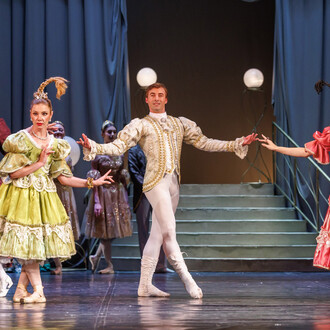The beauty of chaos, but only apparent, of colour that fills the space of composition with no afterthoughts like a musical score with no corrections, that ultimately become a sublime tale. And what better stories to tell than those that symbolize everyday man?
Inspired by Sacred Scripture, Zavattari gives a personal interpretation to biblical episodes as seen through his eyes, those of a contemporary man and artist. He rediscovers the meaning of humanity in the purest and most beautiful sense of the word. Ten canvases and two sculptures make up the new series, inspired by the nuances of the stone of Lecce and the light that bathes the Salento landscape and illuminates its architecture creating effects of chiaroscuro that imprison spirituality on the Baroque facades as in the folds of papier-mâché drapery that local craftsmen mould onto wire frames.
Elevated Conception is a journey within the genius loci of a city and land but also an introspective look at an artist whose work continuously refers to that which is sacred. From Designed Conversations (2002) to Inquiry into the Dark (2012) and Ambidexter (2014), his visual poetics move between art, history, and faith, and are a continuous transfiguration. A faith, not just Christian, but a trail of religiousness, that is primarily an awareness and perception of the sacred, of life as the Sacrifice of Isaac teaches. A value that has been lost in the meanders of an existence trapped in selfishness, the mediocrity of hypocrisy, and the celebration of false idols and ideologies. But against these forms of the brutishness of man, the research for beauty becomes a priority and art the only means of escape. The beauty of a night – that of the miracle of the birth of Jesus – in Midnight in Bethlehem or the essence of motherhood in Mater Divinae Gratiae that with its citations of the canons of classic Marian iconology is a reference to the art of papier-mâché sculpture. Visions from the South (Visioni dal Sud) perceived as a land of welcome rather than a frontier. As in the painting Salento Tempest (Tempesta Salentina), where Justus on voyage to Rome is shipwrecked and saved by Fortunatus and Publius, who once converted, will become Saint Orontius of Lecce.
From the New to the Old Testament, the artist leafs through the pages of Exodus with the sculpture I am who I am (Io sono colui che sono) and the pictorial transposition Projection of I am in 3,14 (Proiezione di Io sono in 3,14). A number which brings to mind the bible verse but also pi and refers to the circularity of the symbols that pervade his paintings such as Canon I (Canone I) of Elevated Conception that epitomizes the different personalities of Baroque Lecce.
Figurations that weave the thread of an intimate dialogue with the place that inspired them. This is confirmed by the use of chromatic colours in line with the tones of the land of Salento as seen in the olive trees and the stylization of houses with flat roofs similar to the faces of dice as in Bodini’s [1] reminiscences. The perfect background for a last supper set among porticoes with star vaults [2] : the bread has been broken, the chalices filled with wine, and the words of Christ “one of you will betray me” still linger in the air, among the apostles in despair, there is one, unperturbed, who dips his bread in the plate of the Master.
The symbolic value of this representation goes beyond sacred narration, the wine/blood on the table is an allusion to the crisis of values, the false conviviality found in homes, in political chambers. And more houses, like the whitewashed lime ones of Salento marked with sacrificial red, in I will go beyond (Io passerò oltre) which together with Have no Fear (Non abbiate paura), anticipate the parting of the Red Sea where the people of Abraham, in flight, head toward a sun/rose-window that greatly recalls the Basilica of Santa Croce (Lecce), in an exodus that has never ended. Unfortunately.
Text by Antonietta Fulvio, co-curator of the new exhibit Elevated Conception – Stone . Paper . Light
[1] Vittorio Bodini was born in Bari in 1914 and raised in Lecce. He was a poet and one of the most important translators of Spanish literature. He was also an expert of the Baroque period.
[2] The Lecce vault or star vault was used in Lecce during the Baroque period and recalls the groin vaults of the Romans.

















